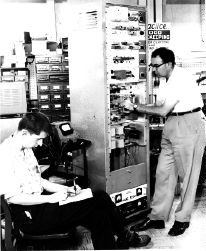



Reading
Room
Thermionic
Audio Books
Last Edited:
12-Sep-2004
| |
In 1954, H.H. Scott perfected and introduced the first
commercially successful Wide-band FM-only tuner, the original 310(A) Broadcast Monitor, a
major factor in the popular acceptance of FM radio for Hi-Fi listening pleasure.
Then, in mid-1961, H.H. Scott was ready when the FCC adopted the current standard (Zenith/GE) for
FM-Stereo multiplex transmissions. Anticipating the FCC's final decision they
were first-to-market with the Type 335 Multiplex
Adaptor. (Also, see the Type 830 FM Multiplex
Stereo Generator and Type 4310 Broadcast Monitor).
By introducing Wide-band technology to its products, Scott's
talented engineering team, led by Chief Research
Engineer, Daniel R. von Recklinghausen,
"future-proofed" their RF products with the first "useable" multiplex
output.

Daniel von Recklinghausen, Chief Engineer, H.H. Scott
(with WCRB Chief Engineer Paul
Day) adjusting WCRB's
first FM stereo generator (H. H. Scott Type 830), during the summer of 1961
Even before commercial stereo multiplex broadcasting
was approved by the FCC (in 1961), wide-band tuner design gave superior quality reception. The
earlier research on VHF FM receivers by Major
Edwin H. Armstrong (see bio by broadcast historian, Donna Hapler), inventor of FM, clearly demonstrated the
inherent advantage of wide-band circuitry. Scott tuners were so reliable they
were often used in commercial broadcast applications (See FM
Relay Networks).
Because of the subtleties of wide-band circuitry, most
manufacturers continued to produce relatively "narrow-band" tuners which give
adequate but not the best results with monophonic FM. It remained for the FCC to
eventually point out the superiority of wide-band design in receiving multiplex: The
FCC-approved (Zenith/GE) multiplex system."
.
. like any multiplex transmission, will increase energy transmission at the
edges of the channel involved. Accordingly, for optimum stereophonic reception the
bandwidth . . . must be considerably greater than that of monophonic . . ."
FCC Report and Order, Docket No. 13506,
04/19/61.
If you could only choose a single vintage H.H. Scott product to
own, most agree it would probably be one of the company's sensitive, and
ground-breaking tuners.
|
